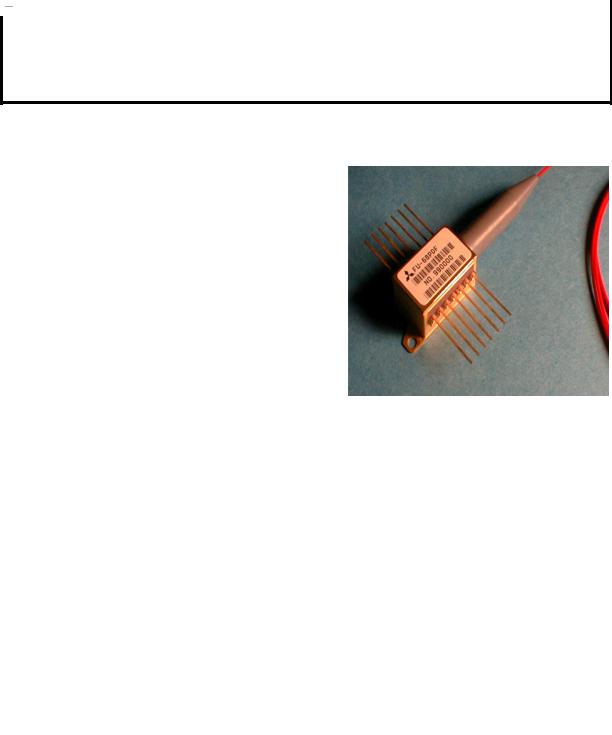Mitsubishi Electric Corporation Semiconductor Group FU-68PDF-510M65B, FU-68PDF-510M64B, FU-68PDF-510M63B, FU-68PDF-510M62B, FU-68PDF-510M61B Datasheet
...
MITSUBISHI (OPTICAL DEVICES)
FU-68PDF-V510MxxB
1.55 μm DFB-LD MODULE WITH POLARIZATION MAINTAINING FIBER PIGTAIL
(WAVELENGTH SELECTED, BIAS CIRCUIT INTEGRATED, DIGITAL APPLICATION)
DESCRIPTION
Module type FU-68PDF-V510MxxB is a 1.55μm DFBLD module with polarization maintaining optical fiber. This module is suitable to a CW light source for external modulator for use in 2.5Gb/s and 10Gb/s digital optical communication systems.
This module is prepared in accordance with ITU-T recommendation wavelength channel plan for DenseWDM transmission.
FEATURES
Input impedance is 25Ω
Multi quantum wells (MQW) DFB Laser Diode module
Emission wavelength is in 1.55μm band Polarization maintaining optical fiber pig-tail Built-in optical isolator
Built-in thermal electric cooler Butterfly package
With photodiode for optical output monitor
APPLICATION
High speed transmission systems (~10Gb/s)
Dense-WDM systems
ABSOLUTE MAXIMUM RATINGS (Tld=Tset)
Parameter |
Symbol |
Conditions |
Rating |
Unit |
|
Laser diode |
Optical output |
Pf |
CW |
15 |
mW |
|
power |
|
|
|
|
|
Forward current |
If |
CW |
150 |
mA |
|
Reverse voltage |
Vrl |
|
2 |
V |
Photodiode |
Reverse voltage |
Vrd |
|
20 |
V |
|
Forward current |
Ifd |
|
2 |
mA |
Thermo- |
Cooler current |
Ipe |
|
1.3 |
A |
electric cooler |
Cooler voltage |
Vpe |
|
3.1 |
V |
(Note) |
|
|
|
|
|
Operating case temperature |
Tc |
|
-20 ~ 70 |
°C |
|
Storage temperature |
Tstg |
|
-40 ~ 85 |
°C |
|
|
|
|
|
|
|
Note) Even if the thermo-electric cooler (TEC) is operated within the rated conditions, uncontrolled current loading or operation without heatsink may easily damage the module by exceeding the storage temperature range. Thermistor resistance should be properly monitored by the feedback circuit during TEC operation to avoid the catastrophic damage.

MITSUBISHI (OPTICAL DEVICES)
FU-68PDF-V510MxxB
1.55 μm DFB-LD MODULE WITH POLARIZATION MAINTAINING FIBER PIGTAIL
(WAVELENGTH SELECTED, BIAS CIRCUIT INTEGRATED, DIGITAL APPLICATION)
ELECTRICAL/OPTICAL CHARACTERISTICS (Tld=Tset, Tc=25°C unless otherwise noted)
Parameter |
Symbol |
Test Conditions |
|
Limits |
|
Unit |
|||||
|
|
|
|
|
|
|
|
Min. |
Typ. |
Max. |
|
Threshold current |
|
Ith |
CW |
|
|
|
|
- |
10 |
25 |
mA |
Operating current |
Iop |
CW, Pf=10mW |
|
|
- |
- |
100 |
mA |
|||
Operating voltage |
Vop |
CW, Pf=10mW |
|
|
- |
- |
1.8 |
V |
|||
Input impedance |
|
Zin |
Pf=10mW |
|
|
|
|
- |
25 |
- |
Ω |
|
|
|
|
|
|
|
|
|
|
||
Light-emission central |
|
λc |
CW, Pf=10mW |
|
|
|
(Note 1) |
|
nm |
||
wavelength |
|
|
|
|
|
|
|
|
|
|
|
Central wavelength drift with |
Δλ |
c/ Tc |
Tc=-20~70 |
° |
C |
|
|
-1 |
- |
0 |
° |
case temp. |
|
|
|
|
|
|
|
pm/ C |
|||
|
|
|
|
|
|
|
|
|
|
|
|
Laser operating temperature |
Tset |
- |
|
|
|
|
20 |
- |
35 |
°C |
|
Spectral line width |
|
f |
CW, Pf=10mW |
|
|
- |
- |
20 |
MHz |
||
Side mode suppression ratio |
|
Sr |
CW, Pf=10mW |
|
|
33 |
40 |
- |
dB |
||
Cutoff frequency |
|
fc |
Pf=10mW |
|
|
|
|
2 |
- |
- |
GHz |
(-1.5dB optical) |
|
|
|
|
|
|
|
|
|
|
|
Polarization extinction ratio |
|
Ex |
CW, Pf=10mW |
|
|
20 |
25 |
- |
dB |
||
Relative intensity noise |
|
Nr |
CW, Pf=10mW, |
|
|
- |
-155 |
-145 |
dB/Hz |
||
|
|
|
0.5~3GHz |
|
|
|
|
|
|
|
|
Tracking error |
|
Er |
Tc=-20~70°C, |
|
|
- |
- |
0.5 |
dB |
||
(Note 2) |
|
|
APC, ATC |
|
|
|
|
|
|
|
|
Differential efficiency |
|
η |
CW, Pf=10mW |
|
|
0.1 |
- |
- |
mW/ |
||
|
|
|
|
|
|
|
|
|
|
|
mA |
Monitor current |
Imon |
CW, Pf=10mW, Vrd=5V |
0.2 |
- |
2 |
mA |
|||||
Optical isolation |
|
Iso |
Tc=25°C |
|
|
|
|
35 |
- |
- |
dB |
|
|
|
Tc=-20~70°C |
|
|
23 |
- |
- |
|
||
Dark current (PD) |
|
Id |
Vrd=5V, Tc=-20~70 |
° |
C |
- |
- |
0.1 |
μ |
||
|
|
|
|
|
|
|
A |
||||
Capacitance (PD) |
|
Ct |
Vrd=5V, f=1MHz |
|
|
- |
- |
10 |
pF |
||
Note 1) See Table 1.
Note 2) Er=max|10×log(Pf / Pf@25°C)|
